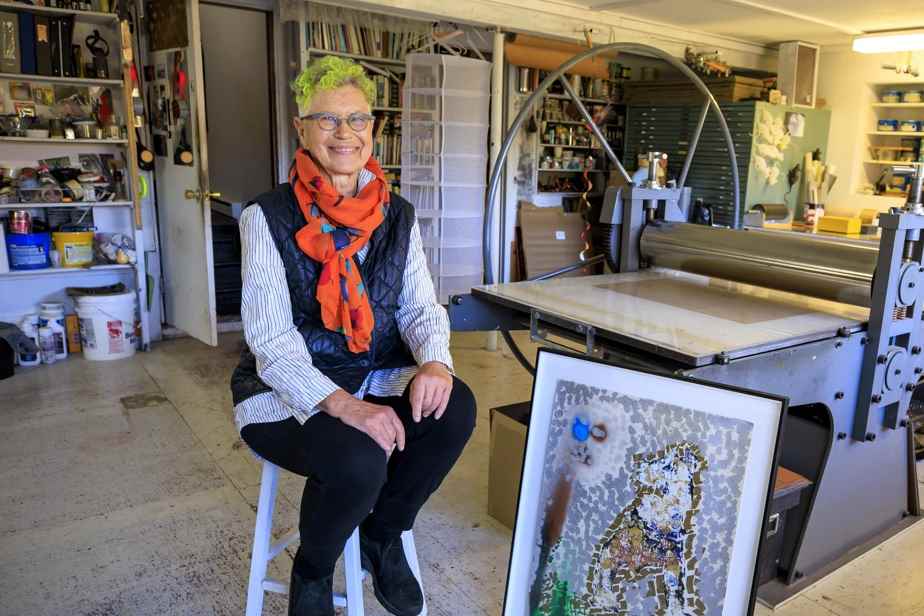Posted at 8:00 a.m.
A solid transplant in Quebec
Born in 1946 in Texas, Bonnie Baxter has lived and created for 50 years in Quebec. Renowned for her engravings, she has touched everything: painting, sculpture, photography, video. She worked with the Atelier de l’île, in Val-David, then created her own studio, Le Scarabée, in 1982. She then met artists and made their prints. Kitty Bruneau, Francine Simonin or even Jean Paul Riopelle.
A regular at the Biennale internationale d’estampe contemporaine de Trois-Rivières and represented by the Blouin Division gallery, she has been teaching at Concordia since 1984. She is very involved in the Laurentians, sharing her knowledge and helping others. Inspired by Aboriginal and Buddhist visions of life, his art encourages us to reflect on our behavior. His corpus RatKind, for example, attempts to change our perceptions of rats. Even if she was twice refused an exhibition on the subject! “It’s racism, this fear of rats,” she said. I found that shocking. Luckily I showed RatKind at the Clark Center! »

PHOTO PROVIDED BY THE ARTIST
Coming Out of Sleep – After Flyspot, 2005, Bonnie Baxter, digital print on canvas, 7 1/2 x 15 feet. Maclau collection.
Ode to foresight
The pandemic has been fruitful for Bonnie Baxter. Confined, she benefited from discussions on Zoom with his students and his two-acre property to set up a project on sharing, the value of things, our connection to nature, how to move forward as a society. The Patch was born. A fable that began with the planting of tomatoes that fed families in the community. She also brought in a dozen performers, including François Morelli, Camille Charbonneau, Johannes Zits, the Australian Jen Rae and the French Mathilde Rohr. To evoke the themes of the project. And weave a narrative.
The Musée d’art contemporain des Laurentides (MACLAU), in Saint-Jérôme, surveyed her to integrate The Patch Trilogy at the exhibition Emporia, an initiative of philosophy teacher Xavier Brouillette on the relationship between philosophy and art. Bonnie Baxter is currently exhibiting The philosopher and the tomato, near works by Stanley February, Philippe Hamelin, Kim Kielhofner and Sophie Latouche. Very zen, the first video of his trilogy, Book 1, lasts one hour. The images are restful, with inspired performances.

PHOTO ALAIN ROBERGE, THE PRESS
Viewing of Book 1
The second film will be released tomorrow and a third on November 13. The tomato season being over, Bonnie Baxter replaced them with 20 bean plants, vegetables distributed at the Val-David food counter.

PHOTO ALAIN ROBERGE, THE PRESS
Bonnie Baxter and her partner Michel Beaudry at MACLAU
Riopelle
In 1985, Bonnie Baxter met Riopelle, her neighbor from Sainte-Marguerite-du-Lac-Masson. “He was looking for someone to make his plates. I prepared them, he scratched them, did his engraving and I did the printing. It lasted almost ten years! We loved working and spending time together. Here, in Estérel or in France. We were open to breaking conformism. »
-

PHOTO LUCETTE LUPIEN, PROVIDED BY BONNIE BAXTER
Jean Paul Riopelle and Bonnie Baxter in Estérel in 1990
-

PHOTO MICHEL BEAUDRY, PROVIDED BY THE ARTIST
Jean Paul Riopelle and Bonnie Baxter in the Le Scarabée studio, in 1987
1/2
They made etchings and etching with the KPR process which required toxic solvents. “I told him it was going to kill me! He advised me to use sugar. I learned to use sweetened condensed milk that I printed on the plate before applying the varnish. The result was perfect and non-toxic! A technique that I taught to my students, very surprised! When Jean Paul came here, we were outside of time and space. I can still hear him wanting to see colors appear and shouting: ”I want to see a sanguine!” It was fantastic. »
The garden-workshop
With her partner, the sculptor Michel Beaudry, Bonnie Baxter lives in an area large enough to have several workshops. But his practice is also external. Their garden dotted with sculptures is a permanent workshop. She creates there, invites her students and organizes parties like in September, her Deck Jam Festival, with performances by artists.

PHOTO ALAIN ROBERGE, THE PRESS
One of Bonnie Baxter’s workshops has a bed, in case of heavy fatigue or for trainees
His artist friends are part of his artistic life. His house is filled with their works, notably by David Lafrance or Dominique Pétrin who decorated a room with his famous screen-printed papers. The room looks immersed in the garden. “This garden is art, work, desire,” says Bonnie Baxter. It’s like a giant painting that I create with flowers, colors, and which changes with the seasons. »
-

PHOTO ALAIN ROBERGE, THE PRESS
Bonnie Baxter in the room decorated by Dominique Pétrin
-

PHOTO ALAIN ROBERGE, THE PRESS
A rat sculpture emerges in the garden
1/2
Bonnie Baxter’s art is an ode to the planet and to sharing. ” The philosopher and the tomato was born in the garden, she said. I am lucky to have created the art that was precious to me. And to share it. I am grateful for life. At 76, she has no plans to retire. On February 2, the Musée des beaux-arts de Sherbrooke will present the exhibition Jean Paul Riopelle/Bonnie Baxter. Tame the Beaston the nearly 10-year collaboration between these two aces of engraving.
Some works
-

PHOTO ALAIN ROBERGE, THE PRESS
Sculptures of RatKind in front of a photograph from the series Jane’s Journey
-

PHOTO ALAIN ROBERGE, THE PRESS
Two recent works by Bonnie Baxter
-

PHOTO ALAIN ROBERGE, THE PRESS
One of the woodcuts installed on the exterior wall of a chicken coop
-

PHOTO PROVIDED BY THE ARTIST
Interference, 2003, Bonnie Baxter. Digital work, silkscreen, print, 76.2 x 203.2 cm.
-

PHOTOS PROVIDED BY THE ARTIST
Two photos from the corpus Jane’s Journey2008
1/5

